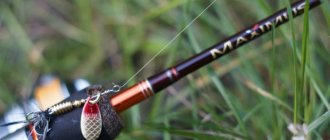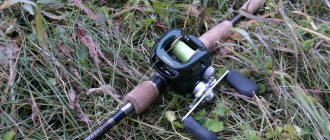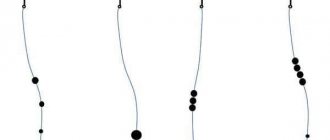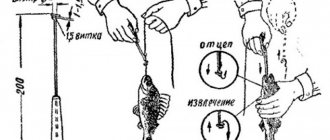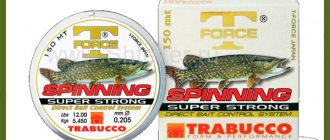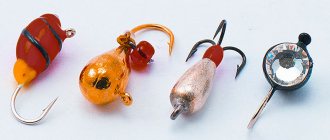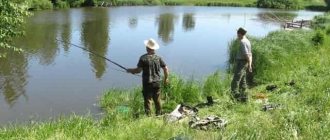Perhaps one of the biggest disappointments for an angler is the lack of bite. Of course, it’s not about the fish, and you can enjoy communicating with nature and fellow hobbyists, however, without the feeling of pleasant heaviness at the other end of the cord, the picture of relaxing with a spinning rod in your hands somehow does not add up to a complete story. Therefore, catching at least something is very important. But what to do if it doesn’t bite? As my grandfather said: “It’s not about the fish, it’s about the fisherman.” So you need to look for the reason, first of all, in yourself. I want to present to your attention five reasons for lack of bite, which, in my opinion, occur in our fishing trips. Maybe one of them is just “yours”?
"There are no fish here"
To earn a bite from a predator, you need to catch it where it is. The mistake of many beginning (and not so beginning) spinning anglers is that they rely solely on fishing luck, and stupidly fish their baits in completely unpromising places! So if you just can’t catch fish with a spinning rod, think about it - maybe you should turn to the literature and “pull up” the theoretical part by studying the characteristic sites of the predator in different reservoirs at different times of the year? Well, if you’re too lazy to read, you can consult with more experienced fishermen live, asking them about fish habits.
Subtleties of spinning fishing
When fishing, it is important to choose a tactic to search for an active predator. Conventionally, two methods of searching for fish can be distinguished: active and passive. The active method involves constant movement in search of interesting areas where a predator can stay.
The passive method is characterized by fishing one or two promising areas with everything that is in the clip. Both tactics can bring success to the spinner if he knows where to look for the predator.
Where to fish?
In search of predator sites, the fisherman needs to navigate through concentrations of small fish, on the movements of which the predatory fish also depends. If small fish are splashing in shallow water, then the pike or perch will most likely stick to the edge of the dump, from where they rush at the prey.
Pike are effectively caught in areas with an abundance of edges, behind which it is convenient for it to hide, lying in wait for fish; near reed walls and at the edge of emergent vegetation; in snarled places; on dry patches and other uneven terrain.
Good to know! Perch, being a schooling fish, does not stand still for long, unlike pike. It can be found in absolutely any area of the reservoir, with the possible exception of riffles. Pike perch prefers holes with a snagged bottom, rocky ridges, from where at dusk it moves to the shallows in search of prey.
When to catch?
You can fish with a spinning rod throughout the open water season: from spring, as soon as the ice melts, until late autumn. The most fruitful time for spinning is when the fish are feeding.
There are several of these throughout the year: two in the spring – pre-spawning and post-spawning; one in autumn, when the fish actively feeds, fattening up fat for the winter.
There is no consensus regarding the most productive time of day for spinning. It is believed that pike actively bite in the first few hours after dawn, and also in the evening a couple of hours before sunset.
Note! However, pike outings, which are not easy to catch, often occur at lunchtime.
Due to the unpredictability of its habits, perch should be expected at any time. And fishing for pike perch is most effective in twilight and at night.
Templates are our enemy!
Educational films about fishing, videos on YouTube, articles in glossy magazines where experienced (and not so experienced) spinners talk about the most catchy baits - this is, of course, good. But blindly copying all the fisherman’s actions from the screen can often play a cruel joke on you, and instead of the desired bites, you will get a zero result. Remember: although the fish are the same, they are still different. The behavior of the same predator in different bodies of water can be very different, so the baits that were so popular in the Volga delta in your favorite video will most likely be completely useless on rivers near Moscow. So, friends, away with stereotypes and blind copying - experiment, and you will be happy!
Diameters of fishing line and braided cord
Depending on the distance and other factors, spinning fishing is carried out using 2 types of fishing line:
- Monofilament. Stretches well. It features high shock absorption when playing fish. But it has low sensitivity when casting long distances. Therefore, monofilament fishing line is used to fish at short distances near the shore, near the boat. For a predator, the recommended thickness is 0.2 mm.
- Wicker. The structure of the thread is rigid. Doesn't stretch. Excellent transmission of bites during long casts. It is convenient to monitor the game of the bait. In terms of strength and breaking load, it is several times superior to monofilament fishing line. They fish with braided line from the shore in wide reservoirs. The optimal diameter is from 0.12 to 0.18 mm.
IMPORTANT! It is recommended to supplement the tackle with a leash when catching a predator such as pike.
Modern materials for leashes are created from Kevlar and fluorocarbon raw materials. It is allowed to use durable leashes made of steel, tungsten, titanium, but their disadvantage is the deterioration of the bait’s performance. The standard leash length is from 15 to 20 cm.
When hunting for another predator, leashes are rarely used. More often, the bait is immediately tied to a thread or a carabiner or clasp is used as an addition. You will need a swivel for rotating spoons - this is protection against twisting and premature deformation of the cord.
Dreams Dreams…
The dream of catching a trophy appears immediately from the moment a person picks up a spinning rod for the first time, and sometimes even earlier. I remember myself as a child, or rather my dreams that preceded the purchase of my first spinning set. I wanted to catch a huge pike, about 5 kilograms - no less. Therefore, I purchased an oak fiberglass spinning rod, wound a 0.4 line with a breaking load of 8 kg on a spool, and bought several “pieces of iron” the size of an adult man’s palm. I thought: “Well, that’s it, now we’ll go fishing!” As a result, I went to my “home” lake for two years without earning a single bite. And I caught my first pike when my ambitions waned and I started fishing for baits up to 3 inches in size. Alas, the realities of modern fishing are such that 90% of the fish in the catches are far from trophy size (unless, of course, you live somewhere in Yakutia), and it is more correct to focus on catching small and medium-sized specimens. As the saying goes, “Better a bird in the hand than a pie in the sky.” And trophies... They will definitely be there, but...
It all starts with gear
But really! Without good balanced spinning tackle it is simply impossible to become a successful spinning player. First of all, you need to consider in more detail the choice of a spinning rod. What are the main differences between different spinning forms?
Test
The first thing you need to note is such a criterion as the rod test. It is the test that determines how well a rod will work in combination with a bait of a certain weight. In general, according to the test, rods can be divided into three main large classes:
- These are light rods with a test weight of up to 10 g,
- Medium rods with dough from 10 to 30 grams,
- Heavy rods with weight over 30 grams.
If you are going perch fishing, then the most reasonable decision would be to purchase a light class . With its help you can throw a miniature bait quite far. In addition, a rod with a small test will allow you to feel even the most careful touches of a predatory fish on the bait. A mid-class rod is well suited for catching predators such as pike and pike perch. But in the case of catching such a giant as freshwater catfish, you should give preference to a heavy rod .
Build
The next criterion by which the form should be evaluated can be called structure. Again, there are three main classes here. All fishing rods are divided into fast, medium and slow .
In the case of a fast action rod, only the first third of it bends under load . The rest of the form remains straight.
A medium action blank bends up to half under load.
A spinning rod with a slow action under load bends into a uniform arc all the way to the handle. It goes without saying that fast action rods are more sensitive. It is for this reason that they are relevant in cases where fishing is done using wobblers or when fishing with jigs. A medium rod is a more versatile option. But a rod with a slow action is great for fishing with spinners. To be fair, it should be said that the overwhelming number of spinning players prefer forms with fast or ultra-fast action.
Types of spinning rods
Also, all spinning rods are divided into telescopic and plug-in . The telescopic form has a greater number of articulation points. And each such joint dampens the energy when biting, which worsens overall sensitivity. It is for this reason that the use of a two-section plug rod when fishing with a spinning rod is more preferable than the use of a telescopic multi-section blank.
Rod length
Short length rods are most often used when fishing from the shore. Moreover, they are most relevant when there are many objects on the shore that impede casting. For example, it could be a coastal shrub. In cramped conditions it is much easier to work with a short rod.
A long rod is perfect when fishing from a boat or when fishing from a clean bank. A long blank makes it possible to make long and accurate casts. The final choice regarding the length of the spinning rod should be made by a novice spinner with an eye on the upcoming fishing conditions. You can settle on some average option.
Spinning reel
As for the reel, most often when fishing with spinning gear, spinning reels are used. They perform simply excellent! The most versatile reels can be considered class 2000 according to the Shimano classification. These reels are intended for use with middle-class spinning rods. At the same time, such a reel will look quite harmonious on a light spinning rod. In general, for light spinning, you should choose a 1000 . But when catching a large predator using heavy tackle, you need to stop at a 4000 .
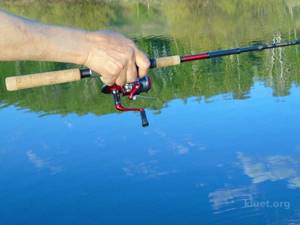
A beginner with no experience can purchase a reel with a rear clutch brake. There's nothing wrong with that. But usually in the case of spinning tackle, reels with a front friction brake are used. This is due to the fact that reels with a detailed drag are lighter in weight compared to their sisters, which have the brake located in the rear of the body. So a beginner should focus on front drag reels.
Fishing line or braid
Nowadays, when fishing with spinning gear, braided cord is usually used. It does not stretch like regular monofilament line. Of course, this has a great effect on the sensitivity of the gear. Fishing with a cord is much more convenient than with a monofilament line! But this imposes certain restrictions on individual parts of the gear. For example, the spool of the reel should be made of aluminum, since the plastic spool will gradually wear out with braided line. Spinning rod rings must have ceramic inserts. It is this material that can resist braided cord.
Leashes
Quite often, beginners forget about the need to install an element such as a leash on the spinning rod. And careless fishermen are very often punished for their frivolity. The bait may well be cut by a pike. It is for this reason that when fishing with a spinning rod you should always use a steel, tungsten or fluorocarbon leader. The choice of leash material deserves a separate article, and therefore we will not dwell on it in detail here.
Should you take fishing rods for fishing?
What do you do when fishing? A strange question, you say... People catch fish while fishing. But as observations of life on the shore show, not everything is so simple... Someone spends most of their time on the beach, someone walks through the forest and collects mushrooms and flowers, and there is a large percentage of those who spend all their fishing at an impromptu table with a glass in hand. By the way, in the latter case, often it doesn’t even come to the point of unsheathing the spinning rod... But fishing, like any other business, loves a serious approach, and if you treat the process anyhow, then, sorry, what kind of bites can we talk about? Of course, you can rely on luck and believe that one of several casts throughout the whole day will be successful, but... I once read the phrase that “There is as much luck in fishing as there is in football.” Therefore, if you want to catch something, then catch it. And if you just want to relax on the shore of a pond, relax. Just pick up trash after yourself.
Choosing bait when fishing with a spinning rod
The modern fishing market has a huge selection of baits for catching freshwater inhabitants of our waters with a spinning rod. When buying lures, it is important for a beginner to understand what he expects from this gear, what kind of fish he is going to catch, in what conditions and with what spinning rod. With proper attention to these points, the fisherman develops a taste for selecting lures.
He will know that when pinching fish to a “ringing”, ultra-fast action form, it is advisable to use jig baits. For a rod that is short up to 210 centimeters and has sufficient rigidity, the fisherman will take wobblers to the pond, the persistent movement of which can be handled by such a spinning rod.
An inquisitive fisherman knows that when fishing in snags or in shallow water, poppers, walkers and other surface baits will help out, and on a bottom richly overgrown with algae and in rocky areas, it is preferable to use all kinds of non-snagging baits.
Good to know! If a spinning angler wants to try his hand at hunting for asp, he will add castmasters and Devons to his arsenal, and to catch chub he will purchase small wobblers and spinners. In short, each fish has its own range of favorite baits. The most common trophies for spinning rods are pike, perch and pike perch, so further we will talk about the baits preferred by these predators.
For pike
- Classic spinners are concave spinners that perform oscillations of varying degrees of intensity in the water, which depends on the constitution of the spinner’s body and the reeling speed. They perform well on pike during the autumn feeding period of this predator.
- Castmasters are heavy and long-range spinners of a specific shape, showing a measured, medium-intensity game, convincingly resembling a wounded fish.
- Asymmetrical spinners are spinners with a shifted center of gravity to the lower part of the body, characterized by sweeping, yaw movements when retrieved.
- Rotating spoons or spinners are spoons with a petal rotating around a metal axis. The spinner comes into action with water resistance, therefore, the faster the speed of the retrieve, the more often the petal rotates. They catch decent pike on spinners number 3 to 5.
- Wobblers are artificial fish made of plastic or wood, differing in body height, size and angle of inclination of the nasal blade. Wobblers with a small blade relative to their length are suitable for catching pike by twitching, and fish with a wide and long blade, capable of diving to great depths, are used in trolling fishing.
- Poppers are bladeless surface baits that, due to a recess in the nose, produce gurgling sounds when pulled with a blank. Ideal for fishing for pike in snags.
- Silicone fish: these include twisters, which have a long and wide arched tail; vibrating tails - an imitation of a fish with a hoof-shaped tail actively wagging in the water; and “edibles” - silicone nozzles soaked in salt and flavorings. The common size of silicone when fishing for pike is 5-12 cm.
For perch
Perch can bite on all the same baits as pike, only their size should be much smaller.
If you try to rank the preferences of perch, the first three places will be taken by:
- turntables number 3;
- silicone baits up to 5 cm long;
- micro-oscillators weighing 2-6 grams.
Of the silicone baits in perch fishing, edible rubber has proven itself to be the best. Manufacturers often create “edibles” in the image of aquatic larvae and crustaceans that perch feed on.
It must be remembered that most of these imitations do not have a pronounced game when fishing, so it is the fisherman’s task to animate them with the tip of the rod. Dragging a silicone crustacean along the bottom, from which the perch picks up food, can be effective.
Recently, the method of catching perch using a retractable leash has gained popularity. This method is indispensable when fishing on difficult terrain. Attaching an end sinker to the main line and mounting it 20-30 centimeters from the weight of a leash up to a meter long with a twister or spinner at the end allows the fisherman to fully control the course of the bait in the bottom layer.
For zander
The list of catchable baits for pike perch is much narrower than that of the above-mentioned predators. This does not mean at all that pike perch will not show interest in a wobbler or spinner, but the main element of pike perch is jig bait:
- Twisters
- Vibrotails;
- Foam fish.
When fishing for pike perch, oscillating spinners are the best catchers, and above all, narrow spinners of the driven type, reminiscent of a minnow or bleak.
Practice, practice and more practice!
Are you still reading this material? It’s better to prepare for fishing and go to the pond as soon as possible. Experience comes with practice, and with experience comes the desired bites. If you want to become a successful spinner, devote as much time as possible to fishing. Don't have the opportunity to travel outside the city often? No problem! An hour with a spinning rod in your hands spent on a nearby city pond is also fishing, a small grain of experience in your bag of experience behind you.
I wish you bites and good chaos.
No tail, no scales
Good mood goes with good fishing
In any business, including fishing, there are things that are not sold in the store. I include such things as optimism and good mood.
Fishing optimism or faith in luck is the basis. You can be as prepared as you like, but without faith in luck there is nothing to do on the river. A good mood is a companion of good luck. If you move along the river with the expression of a “funeral procession” on your face, this will be transmitted to the fish. Minor troubles take on catastrophic proportions. It will all end in terrible psychosis. If you understand that today the whole world is against you, the constellation in the sky is not right, then it’s better not to go fishing. On such a day, you can devote yourself to drinking heavy doses of strong alcohol. The day is gone...

